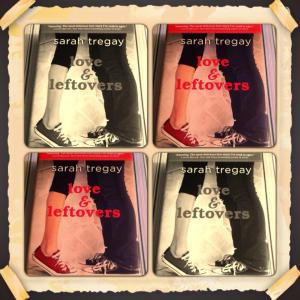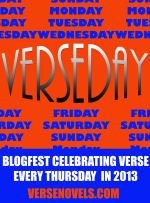 This week VerseDay welcomes verse novelist Carolee Dean.
This week VerseDay welcomes verse novelist Carolee Dean.
One of my favorite verse novels from last year was Carolee Dean’s FORGET ME NOT. I’ve previously highlighted this book as one of the few verse novels that includes a supernatural element but also as one that deals with the issue of teen suicide. This week Carolee dropped into to answer a few questions about FORGET ME NOT
FTWN: You’ve published young adult books in prose before FORGET ME NOT, what made you decide to write in verse?
 CAROLEE DEAN: My previous two novels, Comfort (Houghton Mifflin) and Take Me There (Simon Pulse) both featured boy poets as main characters and contained many original poems. I’ve always wanted to write a novel in verse but my stories usually have a lot of dialogue and it’s not always easy to handle dialogue in verse, especially if there are multiple voices in a scene. Figuring out how to handle that aspect of the story was the greatest challenge. There were several scenes in the “hallway” where multiple characters had interweaving lines of dialogue. I decided to put those scenes in script format which worked especially well since Ally, the main character, is an actress.
CAROLEE DEAN: My previous two novels, Comfort (Houghton Mifflin) and Take Me There (Simon Pulse) both featured boy poets as main characters and contained many original poems. I’ve always wanted to write a novel in verse but my stories usually have a lot of dialogue and it’s not always easy to handle dialogue in verse, especially if there are multiple voices in a scene. Figuring out how to handle that aspect of the story was the greatest challenge. There were several scenes in the “hallway” where multiple characters had interweaving lines of dialogue. I decided to put those scenes in script format which worked especially well since Ally, the main character, is an actress.
FTWN: Unlike many verse novels, and your previous books, FORGET ME NOT contains a strong element of the supernatural. How was writing in this genre different or challenging for you?
 CAROLEE DEAN: I write about contemporary issues so it was important to me to keep that focus. Teens today are dealing with very real life-and-death issues. Forget Me Not explores bullying, social ostracism, and suicide. The supernatural elements of the book serve as metaphors to extend those ideas. For me it was important that the supernatural elements extend, but not over shadow, the contemporary struggles of the characters. Also, I felt that the question of what happens to the soul after suicide would best be explored using the supernatural. It may seem like a “supernatural” idea, but it is a question that many of us have asked when someone we know has chosen to his or her own life.
CAROLEE DEAN: I write about contemporary issues so it was important to me to keep that focus. Teens today are dealing with very real life-and-death issues. Forget Me Not explores bullying, social ostracism, and suicide. The supernatural elements of the book serve as metaphors to extend those ideas. For me it was important that the supernatural elements extend, but not over shadow, the contemporary struggles of the characters. Also, I felt that the question of what happens to the soul after suicide would best be explored using the supernatural. It may seem like a “supernatural” idea, but it is a question that many of us have asked when someone we know has chosen to his or her own life.
FTWN: Your book concerns bullying and cyber-bullying, both very current issues. How do you tap into what is going on with teens today? Do you research, interview?
CAROLEE DEAN: So much of the bullying happening today goes largely unnoticed by adults because it is happening over social media. I work at three different high schools as a speech-language pathologist so I see bullying first hand and hear students talking about their experiences with being bullied. Our staff receive frequent trainings on bully prevention. I also work very closely with the school social workers. We all have lunch together at least once a week. I recently interviewed a couple of them about the phenomenon of girl bullies. If you are interested in reading more about it, the article may be found at http://www.tipsonlifeandlove.com/parenting/how-to-deal-with-girl-bullies.
FTWN: Who are your verse novel inspirations? Any favorite verse novels?
CAROLEE DEAN: Some of my favorites are Crank by Ellen Hopkins, Stop Pretending: What Happened When My Big Sister Went Crazy by Sonya Sones, Chasing Brooklyn by Lisa Schroeder, Make Lemonade by Virginia Euwer Wolff, Girl Coming in for a Landing by April Halprin Wayland, and May B. by Caroline Starr Rose. These are my modern inspirations, but verse novels are actually one of the oldest forms of storytelling and include the Iliad and the Odyssey by Homer as well as Dante’s Divine Comedy. I wrote an article about the history of verse novels at Cynsations which may be found at http://cynthialeitichsmith.blogspot.com/2012/09/guest-post-giveaway-carolee-dean-on.html?m=1
FTWN: What can you tell us about what you are working on now? Will you write another verse novel?
CAROLEE DEAN: I’m currently writing a book about a team or archaeologists and their teen children who accompany them on a dig where an ancient book is uncovered. The events happening in the book parallel the lives of the four teens. It is written in prose but contains verse. I have several ideas for future verse novels. I just wish I had more time to write them!!
FTWN: That sounds awesome. I love archaeology and the premise of the ancient book paralelling the teens’ lives is really cool. I can’t wait to read it.
Thanks for dropping by, Carolee!


 I like this book because, it is funny, sad and happy.
I like this book because, it is funny, sad and happy.




















 BookSpeak! Poems About Books
BookSpeak! Poems About Books  In the Sea
In the Sea Last Laughs: Animal Epitaphs
Last Laughs: Animal Epitaphs Lies, Knives, and Girls in Red Dresses
Lies, Knives, and Girls in Red Dresses National Geographic Book of Animal Poetry: 200 Poems with Photographs That Squeak, Soar, and Roar!
National Geographic Book of Animal Poetry: 200 Poems with Photographs That Squeak, Soar, and Roar!  UnBEElievables: Honeybee Poems and Paintings
UnBEElievables: Honeybee Poems and Paintings  Water Sings Blue
Water Sings Blue